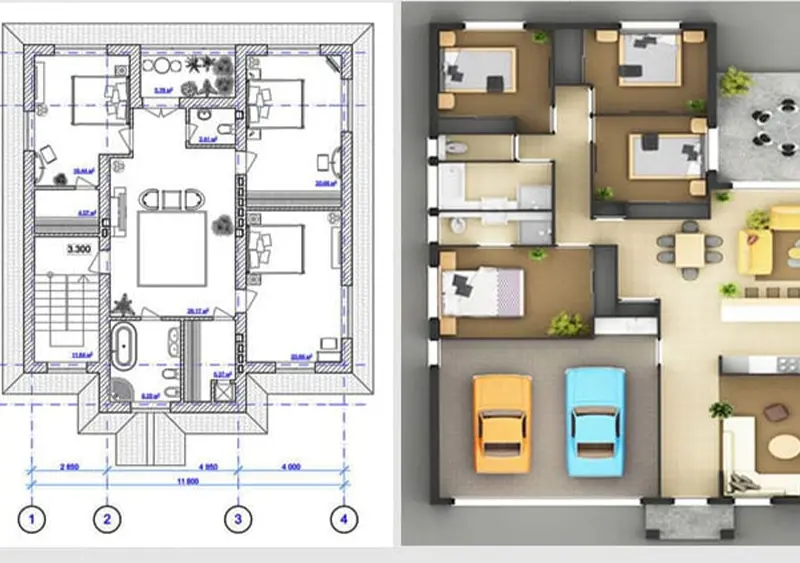3D Floor Plan Rendering vs 2D Plans: Which Is Better for Clients?
Discover which plan style brings your vision to life

5 MIN READ
August 11, 2025

Written By
Harish Selvaraj
That’s the everyday struggle with 2D plans. As architects or developers, we’re trained to read them like second nature. But to a first-time homebuyer or someone visualizing their first commercial space? It’s all lines and boxes. No emotion. No story.
Now flip the scene. You hand them a 3D floor plan furniture in place, colors filled in, depth visible. No confusion. They can feel where their couch would go. They start asking the right questions. The vision just clicks.
This is the difference we’re talking about and in this blog, we’ll break it down in full clarity.
Why Are Floor Plans More Than Just Drawings?
A floor plan is not just a technical requirement. It's the first step in helping someone imagine life inside a space. Whether you're a real estate agent, an interior designer, or a builder your job is not only to build but to help people picture what’s coming.
That imagination gets blocked when the visuals are too abstract. You may have the best design, the most practical layout, the most strategic use of space but if the client can’t see it, they won’t feel it.
And if they can’t feel it, they won’t trust it. That’s why it’s essential to understand the difference between 2D and 3D furniture design, and how the right one can elevate your client's visualization and decision-making experience.
What a 2D Plan Brings to the Table?
2D floor plans are what the industry was built on. They’re fast to draft, highly detailed in a technical sense, and necessary for documentation. A structural engineer, civil contractor, or municipal approval body needs the clarity of a 2D schematic.
These plans show dimensions, door swings, window placements, and wall thicknesses. They’re precise, but they require interpretation. For someone outside the industry, a 2D plan can feel cold. Like reading a map without a destination.
What 3D Plans Offer That 2D Can’t?
3D floor plan rendering services take that same layout and breathe life into it. Walls aren’t lines; they're painted and shaded. Rooms aren’t boxes, they're furnished. Natural lighting is simulated, and every angle reflects realism.
It becomes more than a plan. It becomes an experience.
And in real-world projects, that emotional shift makes a massive difference. Clients don’t ask “where is the master bedroom?” anymore. They ask, “can we fit a study desk here?” because now, they can actually imagine themselves living in that space.
Side-by-Side: Not Just Features, but Feelings Too
Let’s get into the details but not just from a specs perspective. Let's include what the client actually experiences when viewing each.
|
Category |
2D Floor Plan |
3D Floor Plan Rendering |
|
Visual Clarity |
Requires industry knowledge to read |
Instantly understandable to anyone |
|
Emotional Impact |
Low – feels abstract |
High – feels real and inviting |
|
Speed |
Quick to create |
Takes more time, but tells a stronger story |
|
Flexibility |
Hard to edit visually |
Easy to update colors, materials, layout |
|
Presentation |
Suitable for documentation |
Suitable for clients and marketing |
|
Cost |
Affordable |
Slightly more, but higher conversion value |
Now here’s what the table can’t say: 3D floor plans don’t just inform them they sell. They reduce friction in conversations. They cut the time it takes to get approvals. They reduce follow-up questions. Because once a client understands, they don’t hesitate.
What Real Clients Respond To
We’ve seen this firsthand at Zealous. A property developer switched from only sharing 2D PDFs to sending clients a 3D-rendered layout before the site visit. Conversion rates went up. Not because the product changed, but because the perception did.
People are drawn to visual certainty. When you show them what a home or office could be and not just explain it their confidence grows. And confidence sells.
Even clients from abroad, who can’t visit your site in person, rely heavily on 3D plans. It gives them a full sense of scale, design intent, and finishes all before a single wall is built.
Do You Really Need to Choose One?
Here’s where most people get it wrong. It’s not an either-or.
2D plans are essential. You’ll still need them for architects, engineers, and permissions. But when it comes to client-facing conversations 3D makes the pitch easier.
Use both. But use them for the right reasons. Don’t just send a black-and-white drawing to a customer who’s trying to decide if their kitchen will feel too small. Send them something they can believe in.
But when it comes to client-facing conversations 3D makes the pitch easier especially when you understand the difference between 2D and 3D animation.
Final Thoughts:
At the end of the day, the better question is not “which is better” but which helps your client say yes faster.
3D Floor Plan Rendering doesn't just look good. They build trust. And trust moves projects forward.
At Zealous, we focus on one thing: helping your clients make decisions with confidence.
Our 3D floor plans are not over-styled or gimmicky. They’re designed with just the right amount of realism to feel believable, without losing function.
We don’t just deliver visuals. We translate your plans into emotions.
About the writer :
Harish Selvaraj heads Zealous Services' 3D animation and modeling projects, bringing over 17 years of experience in ... delivering top-tier 3D solutions. He collaborates directly with clients to ensure their ideas are transformed into powerful 3D results that meet both creative and business goals. Harish is deeply involved in driving sales and managing teams, making sure that each project delivers on quality while helping businesses grow through impactful 3D designs.
Read MoreFrequently Asked Questions (FAQ)
Why do clients struggle with 2D floor plans?
Most clients aren’t trained to read architectural layouts. Lines and symbols may make perfect sense to architects, but for regular homebuyers or business owners, it’s hard to imagine what those lines mean in real life. That’s where 3D helps it bridge that gap instantly.
Are 3D floor plans just for luxury projects?
Not at all. In fact, they’re becoming common in mid-range and even budget developments. The cost is reasonable, and the value it adds especially in client understanding and faster approvals is worth it for almost any scale of project.
Will I still need a 2D plan if I’m using 3D floor plans?
Yes. 2D plans are still essential for technical teams, permits, and construction drawings. 3D floor plans are best for marketing, client presentations, and helping people visualize the space more naturally.
How long does it take to create a 3D floor plan?
If you already have a 2D plan, a 3D render can be created fairly quickly usually within 2–4 days depending on complexity and revisions. The turnaround is fast, especially when you work with experienced rendering teams.
What makes a good 3D floor plan stand out?
It’s not just about photorealism. A good 3D plan feels balanced, clean layout, realistic materials, right lighting, and a sense of scale. It should help clients instantly understand how the space flows, without overwhelming them with too much styling